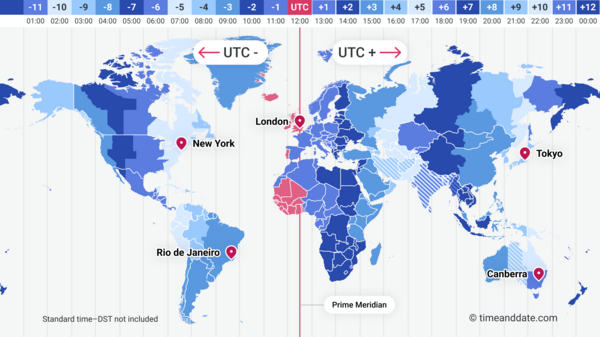UTC: The World’s Time Standard
Coordinated Universal Time (UTC) is the basis for civil time in all time zones worldwide.


The time in every time zone worldwide is defined by its difference, or offset, from UTC.
©timeanddate.com
Point of Reference for Local Times Everywhere
UTC is the time standard commonly used to determine local times around the world. Every time zone is defined by its difference from UTC, known as its UTC offset.
For example, the local time in China is eight hours ahead of UTC, so China Standard Time has a UTC offset of UTC+8. When it’s 09:00 UTC, clocks in Beijing show 17:00 (5:00 pm).
Our complete guide to UTC offsets
UTC Offset Can Shift
While every time zone has a fixed UTC offset, some countries jump back and forth from one time zone to another every year, so the local UTC offset shifts accordingly.
This may sound strange, but if you live in a country that observes Daylight Saving Time (DST), shifting your UTC offset is precisely what you do every time you spring ahead or fall back.
People in New York, for example, follow Eastern Standard Time (EST) during part of the year. It’s five hours behind UTC, so the offset is UTC-5. In early March, clocks go ahead by one hour to Eastern Daylight Time (EDT), reducing the offset to UTC-4.
If you’re the visual type, check out our Time Zone Map—it reflects all DST changes worldwide in real time.
24-Hour Notation
While you’re free to state any time around the world using the 12-hour time format with “am” and “pm” labels, UTC always uses the 24-hour clock, also known as military time.
For example, 7 o’clock in the evening must be written as 19:00 UTC. It is incorrect to write 7:00 pm UTC.
12-hour to 24-hour conversion chart
How UTC Is Measured
Given that so much depends on UTC, it’s no surprise that significant effort goes into ensuring its precision.
Two components are used to keep it ticking at exactly the right pace:
- International Atomic Time (TAI): A time scale that combines the output of some 450 highly precise atomic clocks worldwide.
- Universal Time (UT1): Also known as astronomical time or solar time, it refers to the Earth’s rotation. It is used to compare the pace provided by TAI with the actual length of a day on Earth.
To reconcile the ultra-precise speed of atomic clocks with the fluctuations of Earth’s rotation, a leap second is added to or removed from UTC when the difference between the two components is predicted to reach 0.9 seconds within 12 months.
Leap seconds may soon be a thing of the past

The Prime Meridian in Greenwich, England. The slip-ons are in the Western Hemisphere, and the sneakers are in the Eastern Hemisphere.
©iStockphoto.com/Kateryna Syta
UTC Started in the Seventies
Coordinated Universal Time in its present form was officially adopted on January 1, 1972.
The concept was developed by the International Radio Consultative Committee (CCIR) in the early sixties. In 1967, the International Telecommunication Union (ITU) officially adopted the name UTC, and in 1970, international agreements were reached to set the legal framework for its worldwide implementation.
GMT Used to Be the Global Standard
Although UTC in its present form has only been around for a few decades, the general idea of using a universal time standard to anchor local times worldwide was first put into practice as early as 1884: At the International Meridian Conference, delegates from 25 countries designated Greenwich Mean Time (GMT) as the reference point.
This historical decision is why GMT is still occasionally used as a substitute for UTC today.
At the time, GMT was based on Earth’s rotation—specifically, on the mean solar time at the prime meridian, which runs through the Royal Observatory in Greenwich, London.
With advances in timekeeping technology and the need for a more precise and stable global time standard, UTC eventually replaced GMT. Today, GMT is just another time zone derived from UTC and is no longer based on solar time in Greenwich.